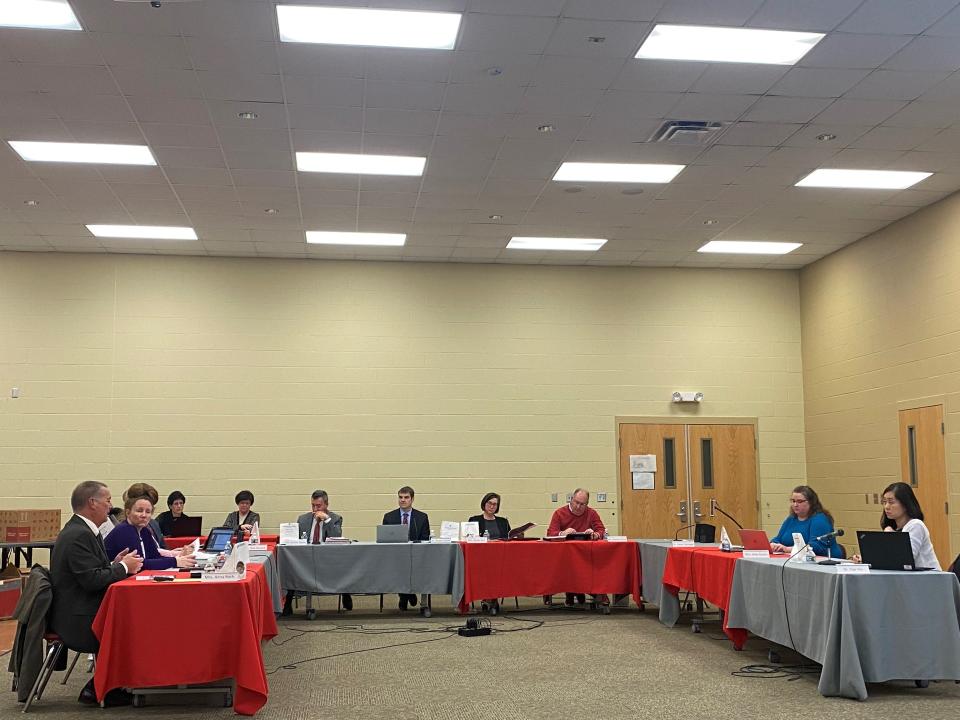West Lafayette school board addresses policy banning transgender athletes
WEST LAFAYETTE, Ind. − Members of the West Lafayette Community School Corp. board Monday passed the first reading of a policy aligning itself with state law prohibiting transgender girls from participating in girls' or women's sports.
At least one board member, Amy Austin, did so begrudgingly, she said, pointing out the district's relationship with the state legislature's ultimatum – passing the "Grievance Procedure for Violation of State Law Limiting Participation of Transgender Girls in Athletics."
"...And so we have to obviously follow the law, we're a state agency, right?" Austin said at Monday's meeting. "But, I didn't feel comfortable letting that go by without mentioning that I will grudgingly do what it takes to follow the law...because people's very personal lives should not be subject to the government's interference."
In May, Republican lawmakers banned transgender girls from participating on sports teams deemed "women's" or "girls'" athletics in Indiana schools. The Indiana General Assembly overturned Gov. Eric Holcomb's veto of the bill, House Bill 1041, earlier this year.
As such, Indiana schools will now be required to align their policies with this new legislation.
Austin spoke of a general lack of personal disapproval with the policy during its reading, pointing out that while the policy may be required, she wanted it known that it is morally not approved by, at least, her.
"I have a lot of friends who have transgender children, I have (transgender members of my family)," Austin said. "It's very important to me that they be allowed to be who they are without politics interfering with their very, very personal lives.
The second reading will come at the next WLCSC board meeting.
The Fanning Howey 10 Year Capital Improvement Plan
The board also discussed the Fanning Howey 10 Year Capital Improvement Plan, presented by Fanning Howey, an architecture and engineering firm that focuses on learning environments. The 10-year improvement plan lists potential, eventual construction needs in buildings throughout the WLCSC.
These plans were not voted on by the board, but are instead more like a collection of information or, as board president Rachel Witt put it, a "dream list" of projects that could be completed.

Synthetic turf
Some improvements listed in the plan include general upkeep projects, such as carpet replacements, the repainting of some areas, roofing improvements, etc. Some of the bigger highlights of the plan include transitioning to synthetic turf on the athletics complex football field.
"One of the major topics that might be in consideration (is) synthetic turf," Bill Payne, project executive for Fanning Howey, said. "I would say that, believe it or not, 20+ years ago the first synthetic turf was put down in Center Grove High School...They are on their third iteration of turf.
"So what that enables you to do is, use that for marching band, for soccer, for football, basically any activity is not precluded from using that surface. Right now you limit your use primarily because of the football season. That natural turf, it can get destroyed because of water, moisture and so forth. And so, it's not as used as much as synthetic turf."
Payne stated that he was not there to promote the use of synthetic turf, but instead to lay out the reasons why synthetic turf has become more common in school corporations throughout Indiana.
The demolition of a portion of Happy Hollow
Previously discussed at the October 2022 WLCSC meeting, part of the improvement plan includes the demolition of a portion of the Happy Hollow Building.
This portion would include the two-story classroom wing of the building that is too expensive to justify construction on it. Portions such as the gymnasium and other newer parts of the building would be maintained.
"We looked at this building... and we came to the same conclusion that (the newest spaces) seem to be the ones that are greatest candidates for retaining. On the other hand, the classroom spaces, both in terms of infrastructure, size, flexibility, technology and so forth, and the exterior window wall...would demand a significant expense to upgrade those to current standards.
"And it does not appear at this point in time that you have a demand for that space. So we're suggesting that conceptually, the highest invest use would be to retain those spaces that I talked about - gym, meeting room, food service, kitchen - those areas that are currently most heavily utilized, maintain those, demolish the two-story portion...and then come back, reface the balance of the building."
Payne listed possible potential uses for the Happy Hollow Building post-demolition as administrative offices and pre-K classroom(s).
The potential uses of the 10 year plan
Witt spoke further about the improvement plan, and how it essentially serves as a reservoir of information for the WLCSC to use when the time comes to complete some of these projects, as well as in the cases of emergencies.
"There is, I'm certain, a validating part of it," Witt said, "that says 'Are we expecting that to break? Yes we are,'...I think it comes down to how can we use that information in a better way and how can we have this be a helpful tool. And that's really what it is, it's a tool that we can use.
"...I don't expect this to happen, but if one of our school buildings, the boilers break and we had no heat for our buildings, we would have to deal with the immediately, right?...What are things, that if (they) were different, we could do (the projects) our absolute best. It's a little bit of a dream list."
Margaret Christopherson is a reporter for the Journal & Courier. Email her at mchristopherson@jconline.com and follow her on Twitter @MargaretJC2.
This article originally appeared on Lafayette Journal & Courier: West Lafayette school board addresses banning transgender athletes

